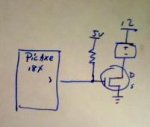flak-spammer
New Member
So I'm kinda new to all this stuff but I'm trying to build a PWM controller that could power something pretty hefty I'd like to start out at about 200w. I'm trying to control the input voltage for a peltier and they are pretty high power devices. I'd like to use the picaxe controller to do this but I have no knowledge of what I should do. Anyone have any suggestions? Circuit Diagrams etc would be useful.

